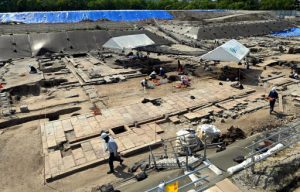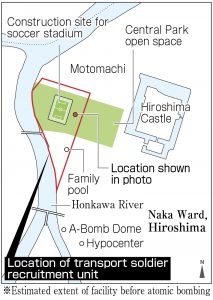Military facility remnants discovered at site of new soccer stadium in Hiroshima’s Central Park—Among largest A-bombed facilities
Jun. 15, 2021
by Kyosuke Mizukawa, Staff Writer
The remains of a military facility destroyed in the atomic bombing have been discovered during excavation carried out by the Hiroshima City government of the site for a new soccer stadium in Central Park, located in Hiroshima’s Naka Ward, it was learned on June 14. The facility belonged to the former Japanese Army’s transport unit known as the Chugoku District transport soldier recruitment unit (“Shichotai” in Japanese). Stables and barracks had been located in an extensive area to the west of Hiroshima Castle, but they were destroyed and many soldiers killed in the atomic bombing by the United States. The remnants are one of the largest A-bombed facilities ever excavated in the city area of Hiroshima.
Last year, the city government began an excavation survey of the construction site to maintain a record of the present circumstances of any artifacts buried underground. The area measures about 14,000 square meters. Commissioned by the city government, organizations including the Hiroshima City Cultural Foundation began an extensive examination in the spring this year of the geologic sediment dated from the time of the atomic bombing. Foundations of buildings, stone pavement, and waterways were found over much of the area.
According to sources, the remnants were identified as the facilities of the army unit based on use of materials such as aerial photographs taken in July 1945 by the U.S. military before the atomic bombing. Artifacts found there are thought to include stables in which horses were reared for the transport of war supplies and that served as watering places for the horses. Also found were steel helmets and eating utensils used by the troops, from which can be discerned how soldiers lived in those times.
The area used by the transport unit stretched from the present-day Central Park family pool facilities to the west side of the park’s open space. Besides horse stables, there were about 30 facilities such as transport vehicle parking areas, barracks, and ammunition warehouses. About 1,000 troops had once been stationed there during the war. The area is less than one kilometer from the hypocenter and was completely burned to the ground in the atomic bombing. More than 400 people were believed to have died there.
The location was developed into a residential area shortly after the war. The former Ministry of Health and Welfare’s housing corporation and other organizations joined together to build many simple frame homes for those who suffered war damages. Since those homes were built in such a hurry that improvement of the scorched area was insufficient, the discovery of “greater-than-expected” remnants was the result.
Hiroshima developed as a military city during and after the Meiji era (1868-1912). There was a cluster of military facilities on the grounds and in the vicinity of the Hiroshima Castle. The former Chugoku Military District Headquarters (former air defense operations offices) are among the A-bombed facilities in this area that survived the bombing.
The city government had planned to hold an on-site briefing session for citizens this month but postponed the gathering due to the continued spread of the coronavirus. The city is currently considering alternatives. The excavation will be carried out until the end of March 2022 as originally planned, but at this point in time the soccer stadium’s construction schedule is not expected to be affected.
Keywords
Chugoku District transport soldier recruitment unit
The Chugoku District transport soldier recruitment unit was assigned to transport arms, ammunition, and food using horses and motor vehicles. Soldiers were trained on site and dispatched to various war fronts. Starting as the fifth platoon of transport soldiers on the west side of Hiroshima Castle in 1880, the unit grew larger and changed names over time. According to the Hiroshima Shicho Heitai Shi (History of Hiroshima Transport Soldiers, in English), published in 1973, 423 people were killed or designated as missing and 343 people were injured in the atomic bombing.
(Originally published on June 15, 2021)









